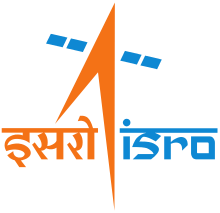IRNSS-1A
IRNSS-1A is the first navigational satellite in the Indian Regional Navigation Satellite System (IRNSS) series of satellites been placed in geosynchronous orbit.[1][2]
| Mission type | Navigation |
|---|---|
| Operator | ISRO |
| COSPAR ID | 2013-034A |
| SATCAT no. | 39199 |
| Mission duration | 10 years |
| Spacecraft properties | |
| Bus | I-1K |
| Manufacturer | ISRO Satellite Centre Space Applications Centre |
| Launch mass | 1,425 kilograms (3,142 lb) |
| Dry mass | 614 kilograms (1,354 lb)[1] |
| Power | 1,660 watts |
| Start of mission | |
| Launch date | 1 July 2013, 18:11 UTC |
| Rocket | PSLV-XL C22 |
| Launch site | Satish Dhawan FLP |
| Contractor | ISRO |
| Orbital parameters | |
| Reference system | Geocentric |
| Regime | Geosynchronous |
| Longitude | 55° E |
| Perigee altitude | 35,706.1 km (22,186.7 mi)[1] |
| Apogee altitude | 35,882.7 km (22,296.5 mi)[1] |
| Inclination | 29.3°[1] |
| Period | 1436.1 minutes[1] |
| Epoch | 22 January 2015, 16:27:41 UTC[1] |
Satellite
The satellite has been developed at a cost of ₹1.25 billion (US$18 million),[3][4] and was launched on 1 July 2013. It will provide IRNSS services to the Indian public, which would be a system similar to Global Positioning System (GPS) but only for India and the region around it.[5]
Each IRNSS satellite has two payloads: a navigation payload and CDMA ranging payload in addition with a laser retro-reflector. The payload generates navigation signals at L5 and S-band. The design of the payload makes the IRNSS system inter-operable and compatible with GPS and Galileo.[6] The satellite is powered by two solar arrays, which generate power up to 1,660 watts, and has a lifetime of ten years.[1]
Launch
The satellite was launched from the Satish Dhawan Space Centre (SDSC) on 1 July 2013 at 11:41 PM (IST).[7] The launch was postponed from its initial launch date of 26 June 2013 due to a technical snag in the 2nd stage of the PSLV-C22 launch rocket.[8] ISRO then replaced the faulty component in the rocket and rescheduled the launch to 1 July 2013 at 11:43 p.m.[9][10]
Scientists from the German Aerospace Centre (DLR)'s Institute of Communications and Navigation in Oberpfaffenhofen, Germany, have received signals from IRNSS-1A. On 23 July 2013, the German Aerospace Center scientists pointed their 30-meter dish antenna at Weilheim towards the satellite and found that it was already transmitting a signal in the L5 frequency band.[11]
Failure
The three Rubidium atomic clocks on-board IRNSS-1A failed, with the first failure occurring in July 2016. ISRO planned to replace it with IRNSS-1H, in August 2017, but this failed to separate from the launch vehicle, [12][13] but on 12 April 2018, ISRO launched successfully IRNSS-1I as a replacement for IRNSS-1A.[14]
The cause of failure was traced to one of the feed through capacitor carrying the DC supply to the physics package of clock, malfunctioning due to excessive rise in temperature.[15]
See also
- Communication-Centric Intelligence Satellite (CCI-Sat)
- GPS-aided geo-augmented navigation (GAGAN)
- Satellite navigation
References
- "IRNSS-1A Satellite details 2013-034A NORAD 39199". N2YO. 22 January 2015. Retrieved 25 January 2015.
- "IRNSS". space.skyrocket.de. Retrieved 8 April 2012.
- "India's first ever dedicated navigation satellite launched". DNA India. 2 July 2013. Retrieved 24 July 2013.
- "India's first dedicated navigation satellite placed in orbit". NDTV. 2 July 2013. Retrieved 24 July 2013.
- "Planned Satellite Launches in 2013". satlaunch.net. 19 March 2013. Retrieved 20 March 2013.
- "IRNSS". space.skyrocket.de. Retrieved 20 March 2013.
- "India launches its first navigation satellite". The Times of India. Retrieved 1 July 2013.
- "Technical snag puts off satellite launch: ISRO". SGP. Retrieved 2 June 2013.
- "PSLV-C22/IRNSS-1A Mission Status". ISRO. Archived from the original on 29 June 2013. Retrieved 26 July 2013.
- S Giri Prasad (14 June 2013). "Indian equivalent of the GPS satellite". The Hindu. Chennai, India. Retrieved 14 June 2013.
- "Indian Regional Navigation Satellite Starts Signal Transmissions". GPS World. 25 July 2013. Retrieved 28 July 2013.
- D.S., Madhumathi. "Atomic clocks on indigenous navigation satellite develop snag". The Hindu. Retrieved 31 January 2017.
- "Questions: Loksabha- Q.No. 1112 Answered on: 08.02.2017".
- "PSLV-C41/IRNSS-1I Mission".
- "Launching of Replacement Navigation Satellite". pib.nic.in. Retrieved 19 July 2018.

